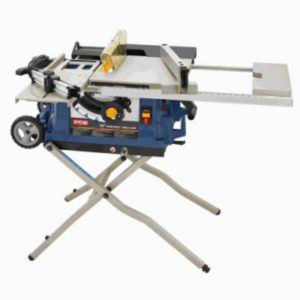In March 2010, Carlos Osorio was awarded $1.5 million in damages in a table saw lawsuit, for hand injuries caused by a Ryobi table saw. The jury found the manufacturers liable for Osorio’s injuries because they neglected to include a flesh-sensing safety device that could prevent nearly all table saw amputations.
The story began in April 2004, when Carlos Osorio was working as a hardwood flooring installer in Massachusetts. Since he had never used a table saw before, his boss gave him instructions and warned him of the dangers. Two weeks later, Osorio was ripping a 2-1/4-inch floorboard on a Ryobi BTS 15 bench-top table saw. When he had difficulty cutting the board, he pushed the wood toward the blade. His left hand slipped into the blade, nearly severing his pinky, and causing severe injury to three other fingers on his left hand. The injury resulted in five hand surgeries, 95 occupational therapy visits, and more than $384,000 in medical bills.
Osorio contacted a lawyer, and filed a table saw lawsuit against One World Technologies, Inc., the manufacturer of Ryobi table saws. The case alleges that Osorio’s injury could have been prevented had the machine been equipped with a safety device. Though Osorio asked for only $250,000 in damages, the jury awarded him $1.5 million.
The controversy over whether table saw manufacturers should be required to include the flesh-sensing safety features has ignited several table saw lawsuits. A safety device called the SawStop has existed for more than a decade, but table saw manufacturers have resisted implementing the device, citing an unreasonable cost to consumers and an unfair monopoly ruled by SawStop manufacturers.
The Consumer Products Safety Commission (CPSC) has been reviewing the matter since 2003, when consumer advocacy groups asked the federal regulatory agency to require manufacturers adopt the safety devices. The Power Tool Institute, a lobbying group that represents the interests of table saw manufacturers, has successfully delayed the CPSC decision until February 2012.
The SawStop safety device could eliminate nearly all table saw amputations. It runs an electrical current through the blade. When the blade is in contact with wood, which does not conduct electricity very well, the current stays relatively constant. If the blade comes in contact with flesh, however, the current in the blade drops significantly, and a sensor triggers a brake mechanism that stops the blade and retracts it into the table saw.
An expert who testified in Osorio’s case said that had SawStop been a feature on the Ryobi table saw he was using, his injuries probably would have only been an 1/8-inch cut on one finger.
Do I have a Table Saw Injury Lawsuit?
Collen A. Clark is a true advocate for his clients and is passionate about helping Texans that have been injured or wronged.
Collen’s amazing success in the courtroom and well known dedication to his clients has earned him the recognition of his peers as one of The Top Trial Lawyers in Texas.”
The Clark Firm has assembled a team of trial lawyers with more than 100 years experience, participation in over 600 jury trials and $60 million in verdicts and/or settlements. Please use the form below to contact us for a free Table Saw Injury Lawsuit review.



 To contact us for a free review of your potential case, please fill out the form below or call us toll free 24 hrs/day by dialing:
To contact us for a free review of your potential case, please fill out the form below or call us toll free 24 hrs/day by dialing: